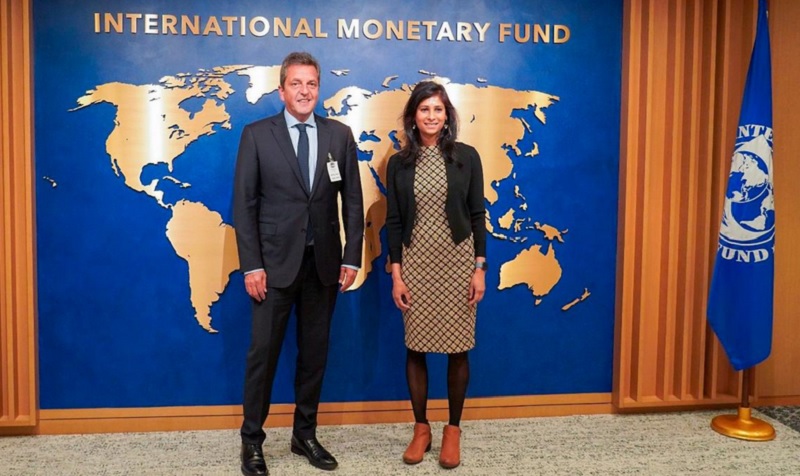
Photo: Press.
He IMF board approved the goals of the fourth quarter of 2022 of the program with Argentina and authorized the transfer of US$ 5,400 million. With this disbursement, the Government pays maturities to the Fund and leaves a balance for the Central’s coffers of around US$ 2,500 million.
After the official tour of the United States and the meetings of Alberto Fernández with the president, Joe Biden, and of Massa with Gita Gopinath, the number two of the IMF, The agency made the reserve accumulation goal more flexible. In return, the northern country was in charge of remembering that it objects to the participation of Chinese companies in the 5G telecommunications tender, in the waterway, and in the construction of nuclear power plants.
The effects of the drought and the war were not enough for the Fund. The agency’s board of directors maintained the primary fiscal deficit target (considers it “essential”) for this year that should fall to 1.9% of GDP in relation to the 2.5% scheduled in 2022. The Fund suggests in the statement move forward with raising energy rates for high-income residential and commercial users and introduce “tight regulations” in the new retirement moratorium to reduce the “fiscal cost” of the measure, that is, to impose restrictions so that fewer people can access a retirement. He also insisted on his classic recipes for raise interest rates so that in real terms they are positive, a measure that slows down economic activity because it makes credit for production and consumption more expensive, and to continue with the mini-devaluations of the official exchange rate (“crawl rate”), which will push prices up.
The IMF indicated that “additional tightening of macroeconomic policy and additional modifications to exchange rate policy may be required to safeguard macroeconomic stability.” Do you mean a higher fit o one exchange rate jump? Both measurements are part of your manual. These are the consequences of continuing under the command of the Fund, which will continue with quarterly reviews of the Argentine economy. The agency’s bureaucrats will say what is right and what is wrong with the permanent blackmail of their decision to send fresh funds to cancel the promised payments.
Massa on the hunt for dollars
Faced with the “lack” of dollars, the Minister of Economy scratches the pot again (after announcing the slap to the resources of the Anses) and grants a new benefit for the agrarian employers, the farm dollar, a differential exchange rate for soybeans and regional economies. The fine print of the differential exchange rate is expected to be published in the Official Gazette.
He soybean dollar It already had two versions. The first was in September, at a value of $200 per dollar, where US$ 8,100 million was settled, and the second version was in December, and the agricultural employers settled foreign currency for US$ 3,155 million. This measure represented an additional gain for the field of more than US$ 200,000 million and more than US$ 130,000 million, respectively. On the counter was the issuance of a Treasury Bill in dollars, with a term of ten years, to compensate the Central Bank for the difference between the official price of the currency and that of the “soybean dollar”, that is, more debt was generated.
Pending official confirmation of a higher dollar, the agro-exporters hardly made any operations, last Friday, according to the Rosario Stock Exchange, “in the soybean market there were no open purchase offers for the acquisition of merchandise.”
Who were the companies that have already won with the previous versions of the soybean dollar? Cargill, General Deheza Oil, Viterra, Bunge, Agro Mills, Cofcoamong other. In this new version, large winemakers, sugar mill owners, and other large companies that export products from regional economies will surely be added. This measure will also impact the rise in other prices since exporters will prioritize selling abroad and this decreases the supply of products in the domestic market. For example, it is likely that the price of products to produce balanced feed for animals will increase, which will push up the prices of eggs, milk, dairy products, poultry, pork and beef.
Honor the debt in a country with poorer
Massa and his galley rabbits only postpone the problem of the dollars necessary to face the debt maturities that the country has ahead of them and that both the ruling party and the bosses’ opposition intend to honor.
Since the Government of the Frente de Todos took office, US$ 27,816 million have been paid to the IMF, but disbursements of US$ 24,322 million have been received, according to the response of the Chief of the Cabinet of Ministers to the question asked by the PTS in the Left Front on maturities and payments to the IMF. This means that almost US$3.5 billion have been lost so far during his government to pay the Fund. According to the Headquarters report, as of February 28 of this year US$ 52,990 million is owed to the international organization: U$S 42,919 million principal and U$S 10,070 million interest with the following maturity schedule.

Table presented in Report 135 of the Chief of the Cabinet of Ministers.
For 2023 and 2024 there will be IMF disbursements of US$ 16,678 million and US$ 3,355 million, respectively, the document clarified. This year more is paid than received (-U$S 177 million), in 2024 the disbursement of the organization will only cover half of the maturity, and the last transfer that the Fund will make will be in September 2024. Starting in 2025, how will the country pay the outstanding maturities? Maturities since that year represent four times more than the country’s trade balance (difference between exports and imports).
To this account we must add the payment to other multilateral organizations and the debt restructuring that former minister Martín Guzmán made with the wolves of Wall Street. According to the same report from Headquarters in 2022 US$ 896 million were paid for the Global bonds and in 2023 and 2024 approximately US$ 1,329 million and US$ 2,601 million will be paid, respectively.
“The foreign currency requirements to service the external debt are high, limiting the possibility of dollars for other uses”, warns the doctor in Economics Noemí Brenta in her book History of the Argentine external debt. From the dictatorship to the present day. This is a recurring problem in Argentina. The “lack” of dollars o “external constraint” it’s a structural problem of the economy, a large part of the currencies are going to pay previous debt, for the flight of capital and turns of profits of the multinationals.
Government after government stayed in the debt business and restructured to keep paying. This only served the interests of the most concentrated business sectors and international financial capital. But the working class bore the cost of paying down the debt, and this is again the plan for when it can’t be repaid.
“Argentina’s foreign debt is an extremely fragile and dangerous crystal, capable of ruining the lives of the vast majority of the country’s inhabitants,” Brenta stated in the aforementioned book. This has already been experienced by the country and can be seen in the persistent increase in poverty from the dictatorship to the present or in the rise in job insecurity. The cruelest face is child poverty that in 2022 affected 6 million boys and girls. According to a report from the Argentine Catholic University, child poverty from 1996 to 2019 did not break the floor of 38% (2013), a high percentageeven in the best years of economic growth during the Kirchner governments due to the boom in commodity prices.
This is the decadence imposed by the capitalist class and its political parties, but there is another way out. A set of measurements of another class such as the sovereign disregard of debtthe nationalization of the banking system and foreign trade under the management of the workersamong other. A program so that the crisis this time is paid for by big businessmen.
Source: www.laizquierdadiario.com

